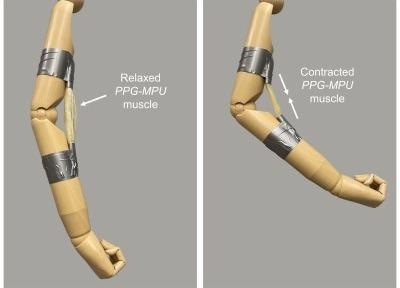Reviewed by Alex SmithSep 9 2021
Shape memory polymers get back to their original shapes upon applying heat or light. This happens when they are subjected to stretching or deforming. Such materials exhibit great potential for soft robotics, smart biomedical devices and deployable space structures. However, so far they have not been able to store sufficient energy.

An artificial muscle made of a stretched shape memory polymer contracts upon heating, bending a mannequin’s arm. Image Credit: Adapted from ACS Central Science 2021, doi.org/10.1021/acscentsci.1c00829.
According to a study published recently in ACS Central Science, researchers have designed a shape memory polymer that is capable of storing nearly six times more energy compared to previous versions.
Shape memory polymers shift between an original, undeformed state and a secondary, deformed state. The deformed state is made by stretching the polymer and is held in place by molecular changes, like dynamic bonding networks or strain-induced crystallization that are reversed with the help of light or heat.
Furthermore, the polymer returns to its original state via the discharge of stored entropic energy. However, for researchers, it is difficult to make these polymers execute energy-intensive tasks. Zhenan Bao and collaborators wanted to design a new kind of shape memory polymer that extends into a stable and highly elongated state. This enables it to discharge enormous amounts of energy while returning to its original state.
The scientists integrated 4-,4’-methylene bisphenylurea units into a poly(propylene glycol) polymer backbone. In the original state of the polymer, the polymer chains were tangled and disorganized.
Due to stretching, the chains were aligned and it developed hydrogen bonds between urea groups, thereby making supermolecular structures that stabilized the highly elongated state. Heating was responsible for the breaking of the bonds and also for the contracting of the polymer to its initial and disordered state.
Tests revealed that the polymer was capable of stretching up to five times its original length and storing up to 17.9 J/g energy – nearly six times more energy compared to previous shape memory polymers. The researchers showed that the stretched material could utilize this energy to lift objects 5,000 times their weight once subjected to heating.
Also, an artificial muscle was created by fixing the pre-stretched polymer to the upper and lower arm of a wooden mannequin. On being heated, the material contracted, making the mannequin bend its arm at the elbow.
According to the researchers, the shape memory polymer not just features record-high energy density but is also affordable (raw materials cost of around $11 per lb) and simple to make.
The researchers acknowledge financial support from the U.S. Department of Defense, the National Science Foundation, and the U.S. Department of Energy.
Journal Reference:
Cooper, C. B., et al. (2021) High Energy Density Shape Memory Polymers Using Strain-Induced Supramolecular Nanostructures. ACS Central Science. doi.org/10.1021/acscentsci.1c00829.